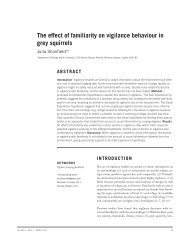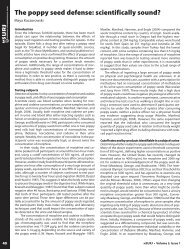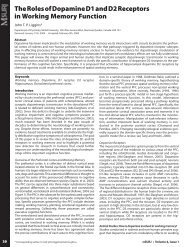the entire issue - McGill Science Undergraduate Research Journal ...
the entire issue - McGill Science Undergraduate Research Journal ...
the entire issue - McGill Science Undergraduate Research Journal ...
You also want an ePaper? Increase the reach of your titles
YUMPU automatically turns print PDFs into web optimized ePapers that Google loves.
Operational transformation in cooperative software systems<br />
quire real-time delivery of user actions, which most blogs, wikis, and<br />
representational state transfer (RESTful) web applications would be<br />
considered. However, for modern web applications that require realtime<br />
collaboration, <strong>the</strong>re are several challenges that need to be overcome.<br />
Data must often be broadcasted from <strong>the</strong> server to <strong>the</strong> client,<br />
to keep <strong>the</strong> results of user actions up to date. This “server push”<br />
can be simulated through continuous polling of <strong>the</strong> HTTP resource,<br />
or keeping a live client-server connection, but this often results in<br />
a fragile connection, as it uses <strong>the</strong> HTTP protocol in a way that it<br />
was not intended to be used. Beyond <strong>the</strong> problems associated with<br />
response time, traditional pessimistic concurrency schemes, where<br />
a document is locked while one user is updating it, are often poor<br />
for developing real-time applications due to a lower responsiveness<br />
(2, 3).<br />
Collaborative editing systems<br />
One of <strong>the</strong> more well-known applications of real-time web services is<br />
those of collaborative editing systems such as Google Docs or E<strong>the</strong>rpad<br />
(14). These services provide traditional word processing and<br />
spreadsheet applications, but through a shared interface that allows<br />
simultaneous editing of a document.<br />
There are three main characteristics that define a collaborative editing<br />
system (6):<br />
1.<br />
2.<br />
3.<br />
Real-time: The local client interface should have a fast response<br />
time. Optimally, it should have a response time similar to a single-user<br />
editor.<br />
Distributed: Each user may be geographically separated, from<br />
different machines to different communication networks, with<br />
varying latency delays.<br />
Unconstrained: Any user can freely edit any part of <strong>the</strong> document<br />
at any time, without any constraints.<br />
Instead of a pessimistic concurrency scheme, collaborative editing<br />
systems often use an optimistic concurrency scheme, where a nonlocking<br />
transaction scheme is used. Replication is often used in order<br />
to allow <strong>the</strong> local client interface to respond quickly, by having local<br />
actions immediately update <strong>the</strong> local copy of <strong>the</strong> document. These<br />
factors provide <strong>the</strong> necessary responsiveness for real-time applications,<br />
but now lead to a new difficulty: maintaining consistency and<br />
properly resolving conflicts throughout <strong>the</strong> document, while multiple<br />
clients are concurrently editing it (8, 9).<br />
Optimistic concurrency techniques<br />
Optimistic concurrency techniques have been well-studied within<br />
<strong>the</strong> context of databases and distributed simulations, which make<br />
<strong>the</strong> assumption that data contention between two different transactions<br />
are rare, and conflicts rarely happen. These techniques are of-<br />
ten used through web user interfaces, as <strong>the</strong> stateless nature of HTTP<br />
makes it difficult for locks to be used, since a user can simply leave<br />
a web page at any time without notifying <strong>the</strong> application that <strong>the</strong>y<br />
have cancelled <strong>the</strong>ir transaction.<br />
The simplest form of optimistic concurrency control commits a<br />
transaction only when all necessary changes have been tentatively<br />
completed, and no conflicts from o<strong>the</strong>r transaction have occurred.<br />
If a conflict has occurred, a “rollback” is used to revert a data object<br />
back to a previous, non-conflicted state, and <strong>the</strong> transaction which<br />
attempted to commit is annulled. This guarantees that our data is<br />
always valid and consistent, though this simple form of optimistic<br />
concurrency will not be successful in areas where many conflicting<br />
operations may occur. The lessened overhead due to locks being unnecessary,<br />
however, can lead to greater throughput if <strong>the</strong> number of<br />
conflicts is few.<br />
However, for collaborative editing systems, conflicts occur often,<br />
making <strong>the</strong> simple optimistic concurrency technique infeasible. In<br />
later sections, we will discuss <strong>the</strong> modifications that operational<br />
transformation makes to <strong>the</strong> simple optimistic concurrency technique<br />
that make rollbacks unnecessary for resolving conflicts.<br />
Consistency models<br />
Consistency models define <strong>the</strong> rules that determine what data each<br />
client can see in memory, when a particular set of operations have<br />
been performed by different clients. An example of when an inconsistency<br />
can arise is when one client writes to its own local copy of<br />
data in a distributed data store, but has not yet propagated those<br />
changes over to <strong>the</strong> o<strong>the</strong>r clients. If those o<strong>the</strong>r clients wish to read<br />
or write to that data, <strong>the</strong>n <strong>the</strong>y may be using an older version of <strong>the</strong><br />
data that has not taken into account <strong>the</strong> o<strong>the</strong>r client’s modifications.<br />
For collaborative editing systems, several consistency models have<br />
been defined to formally verify <strong>the</strong> properties that clients must support<br />
to successfully resolve conflicts in <strong>the</strong> local copies of <strong>the</strong>ir documents.<br />
We discuss one of <strong>the</strong> more commonly referenced models<br />
by Sun et al. (12), which suggests that consistency in a cooperative<br />
editing system be defined by three properties based on each of <strong>the</strong><br />
operations (discrete transactions submitted by each client):<br />
1.<br />
2.<br />
Convergence: When <strong>the</strong> same set of operations has been executed<br />
at each site, <strong>the</strong>n <strong>the</strong> copies of <strong>the</strong> document are also<br />
identical.<br />
Causality preservation: Given two operations O A<br />
and O B<br />
if O A<br />
→<br />
O B<br />
(O A<br />
causally occurred before O B<br />
), <strong>the</strong>n O A<br />
is executed before O B<br />
at each site.<br />
Volume 8 - Issue 1 - March 2013 63









